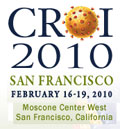An ongoing dialogue on HIV/AIDS, infectious diseases,
February 28th, 2010
CROI 2010 Recap: No Obvious Blockbusters, But …
 Ok, I’ll admit it — I didn’t see any studies presented at CROI this year that will immediately transform HIV care on a day-to-day basis. Nothing that will alter practice right now.
Ok, I’ll admit it — I didn’t see any studies presented at CROI this year that will immediately transform HIV care on a day-to-day basis. Nothing that will alter practice right now.
Nothing like last year’s NA-ACCORD, or 2008’s surprising DAD study, or 2007’s raltegravir studies, to name a few recent examples.
(All subsequently published, of course — links are to the papers.)
Still, as usual, lots to think about:
- Does expanded HIV treatment reduce new infections? Maybe …
- Could the rest of the country expand HIV testing and linkage to care the way they have done in Washington, D.C.? Wow, those are impressive data.
- Can a 4-drug-in-one pill treatment compete with what we have, or will have? You decide.
- Is boosted atazanavir as good as efavirenz? Seems so.
- What are the long-term consequences of these changes in renal function or bone health? The extent to which our treatments accelerate aging remains a major open question.
- Is there any doubt that letting the CD4 cell count fall increases the risk of non-AIDS complications? I don’t think so. (Multiple other papers with similar findings.)
- Is tenofovir the only drug associated with renal dysfunction? Not according to this study.
- Could there be a (broader) role for a CCR5 antagonist? Especially one that is once-daily and does not require boosting? This drug looks promising, but frankly I don’t see it unless a better tropism test can be worked out — or even better, if there’s some non-antiviral utility to these drugs, or (hope of hopes) they can be part of a “cure”.
- Is “intensification” dead? Maybe not, but it’s clearly on life support. See studies with raltegravir, maraviroc, and enfuvirtide for the evidence.
But just when we think we have it all figured out, there are these two excellent overviews of how we neither have a cure for HIV (Maldarelli) nor can we treat all our patients successfully (Eron).
These are great summaries of two remaining challenges in the field, and well-worth the web casts — which are viewable here.


Great recap, Dr. Sax. Much appreciated.